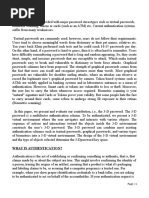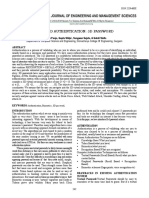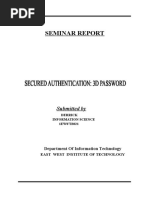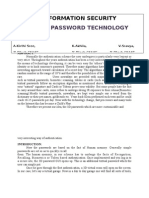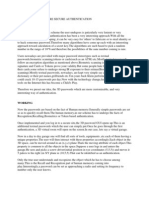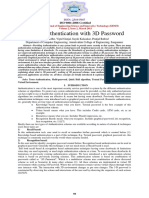3d Password
3d Password
Uploaded by
krishna4143Copyright:
Available Formats
3d Password
3d Password
Uploaded by
krishna4143Copyright
Available Formats
Share this document
Did you find this document useful?
Is this content inappropriate?
Copyright:
Available Formats
3d Password
3d Password
Uploaded by
krishna4143Copyright:
Available Formats
3D PASSWORD
ABSTRACT
Current authentication systems suffer from many weaknesses. Textual passwords are commonly used; however, users do not follow their requirements. Users tend to choose meaningful words from dictionaries, which make textual passwords easy to break and vulnerable to dictionary or brute force attacks. Many available graphical passwords have a password space that is less than or equal to the textual password space. Smart cards or tokens can be stolen. Many biometric authentications have been proposed; however, users tend to resist using biometrics because of their intrusiveness and the effect on their privacy. Moreover, biometrics cannot be revoked. In this paper, we present and evaluate our contribution, i.e., the 3-D password. The 3-D password is a multifactor authentication scheme. To be authenticated, we present a 3-D virtual environment where the user navigates and interacts with various objects. The sequence of actions and interactions toward the objects inside the 3-D environment constructs the users 3-D password. The 3-D password can combine most existing authentication schemes such as textual passwords, graphical passwords, and various types of biometrics into a 3-D virtual environment. The design of the 3-D virtual environment and the type of objects selected determine the 3-D password key space.
You might also like
- AZURE AZ 500 STUDY GUIDE-1: Microsoft Certified Associate Azure Security Engineer: Exam-AZ 500From EverandAZURE AZ 500 STUDY GUIDE-1: Microsoft Certified Associate Azure Security Engineer: Exam-AZ 500No ratings yet
- Three Dimensional Password For More Secure Authentication: Name: Manila M V ROLL NO: CS08M028Document2 pagesThree Dimensional Password For More Secure Authentication: Name: Manila M V ROLL NO: CS08M028swaroopjainNo ratings yet
- Smart CardsDocument1 pageSmart CardsNandu ShriNo ratings yet
- SemiDocument14 pagesSemishanuhardikNo ratings yet
- 3D Passwords Table of Contents: TitleDocument14 pages3D Passwords Table of Contents: TitleArathy VikramNo ratings yet
- Secured Authentication: 3D PasswordDocument4 pagesSecured Authentication: 3D PasswordLEESHMANo ratings yet
- Acknowledgement: 3D PasswordDocument35 pagesAcknowledgement: 3D PassworddreamsasiNo ratings yet
- 3d Password Seminar ReportDocument35 pages3d Password Seminar ReportAakash Kumar SinhaNo ratings yet
- Advance Authentication Technique: 3D Password: Pooja M. Shelke F. M. Shelke Mr. B. G. PundDocument4 pagesAdvance Authentication Technique: 3D Password: Pooja M. Shelke F. M. Shelke Mr. B. G. PundEditor IJRITCCNo ratings yet
- Title: Three-Dimensional PasswordDocument1 pageTitle: Three-Dimensional Passwordsanjee2No ratings yet
- 3d SeminarDocument11 pages3d SeminarAfroz HnyNo ratings yet
- Acknowledgement: 3D PasswordDocument37 pagesAcknowledgement: 3D PasswordMuthu SelvamNo ratings yet
- 3D Password Modern Approach To Security: AbstractDocument8 pages3D Password Modern Approach To Security: AbstractSujith saNo ratings yet
- 3d PasswordDocument28 pages3d PasswordAmar PandaNo ratings yet
- More Secured Authentication 3d Password IJERTCONV3IS10042Document5 pagesMore Secured Authentication 3d Password IJERTCONV3IS10042Shubham SagarNo ratings yet
- 3d PasswordDocument18 pages3d Passwordsuriya rashmiNo ratings yet
- Documentation 3d PasswordDocument23 pagesDocumentation 3d PasswordSiligam Pranitha100% (2)
- Secured AuthenticationDocument9 pagesSecured AuthenticationAmutha ArunNo ratings yet
- 7 VI June 2019Document6 pages7 VI June 2019Shubham SagarNo ratings yet
- Submitted By: Name: S.Vaishnavi@ Bhavani Class: II M.SC (CS & IT) Roll - No: BPN10Document20 pagesSubmitted By: Name: S.Vaishnavi@ Bhavani Class: II M.SC (CS & IT) Roll - No: BPN10Vaishu SadhaNo ratings yet
- 3d Seminar ReportDocument19 pages3d Seminar ReportYudi19100% (1)
- 3 DPSWDDocument25 pages3 DPSWDpadikalagopichandNo ratings yet
- Ijs DR 1904006Document6 pagesIjs DR 1904006Shubham SagarNo ratings yet
- SEMINAR Phase OneDocument14 pagesSEMINAR Phase Onegadisa gemechuNo ratings yet
- 3d PasswordDocument17 pages3d PasswordRamchandra Singh100% (1)
- Department of Computer Science & Engineering, VVITDocument27 pagesDepartment of Computer Science & Engineering, VVITrajkumar mikkilkiNo ratings yet
- 3D Password PptsDocument22 pages3D Password PptsVidhya ChouguleNo ratings yet
- ORGINALDocument29 pagesORGINALSrinivas Chowdary DirisalaNo ratings yet
- A Review On Secured Authentication Using 3D Password: M. Padmaja P.ManjulaDocument6 pagesA Review On Secured Authentication Using 3D Password: M. Padmaja P.ManjulaEditor InsideJournalsNo ratings yet
- 3D Password: Minimal Utilization OF Space AND Vast Security Coupled With Biometrics FOR Secure AuthenticationDocument7 pages3D Password: Minimal Utilization OF Space AND Vast Security Coupled With Biometrics FOR Secure AuthenticationArunChirappurathNo ratings yet
- A Technical Seminar OnDocument6 pagesA Technical Seminar OnRavikryitNo ratings yet
- Literature Review of 3d PasswordDocument7 pagesLiterature Review of 3d Passwordafmzvadopepwrb100% (1)
- Seminar Report'10 3-D PasswordDocument22 pagesSeminar Report'10 3-D Passwordthulasi1991No ratings yet
- MIC College of Technology: Technical Seminar ReportDocument13 pagesMIC College of Technology: Technical Seminar ReportSarat PendelaNo ratings yet
- Seminar Report: Submitted byDocument29 pagesSeminar Report: Submitted byNeha Vinod Holamoge80% (5)
- Information Security: 3D Password TechnologyDocument4 pagesInformation Security: 3D Password TechnologyakhilakaviNo ratings yet
- 3D PASSWORD SEMINAR REPORTDocument9 pages3D PASSWORD SEMINAR REPORTየኢየሱስ ነኝNo ratings yet
- A Novel 3D Graphical Password Schema: Fawaz A Alsulaiman and Abdulmotaleb El SaddikDocument4 pagesA Novel 3D Graphical Password Schema: Fawaz A Alsulaiman and Abdulmotaleb El SaddikSudhanshu KumarNo ratings yet
- Advanced Authentication Using 3D Passwords in Virtual World: Nisha Salian, Sayali Godbole, Shalaka WaghDocument6 pagesAdvanced Authentication Using 3D Passwords in Virtual World: Nisha Salian, Sayali Godbole, Shalaka WagherpublicationNo ratings yet
- 29 Ijmtst0802099Document5 pages29 Ijmtst0802099Akshay JadhavNo ratings yet
- 3D PasswordDocument9 pages3D PasswordakashNo ratings yet
- 3D PasswordDocument18 pages3D PasswordVarun PandeyNo ratings yet
- 3D PasswordDocument18 pages3D PasswordNaresh KumarNo ratings yet
- 3 D PasswordDocument21 pages3 D PasswordAtisha SharmaNo ratings yet
- 3d Password For More Secure AuthenticationDocument12 pages3d Password For More Secure AuthenticationYojana ReddyNo ratings yet
- Maharana Pratap College of Technology: Seminar On: 3D PASSWORD CS 507Document22 pagesMaharana Pratap College of Technology: Seminar On: 3D PASSWORD CS 507sd2808No ratings yet
- dagne 3D PASSWORD REPORT NEWDocument8 pagesdagne 3D PASSWORD REPORT NEWየኢየሱስ ነኝNo ratings yet
- 3D Password Sakshi 53Document17 pages3D Password Sakshi 53Shikhar BhardwajNo ratings yet
- 3D Password Authentication: 1.abstractDocument7 pages3D Password Authentication: 1.abstractSaqlain AsadNo ratings yet
- 3d SynopsisDocument13 pages3d SynopsisYOGENDRANo ratings yet
- 3d Password For More Secure AuthenticationDocument7 pages3d Password For More Secure AuthenticationRukshana MeeranNo ratings yet
- Paper 3079Document6 pagesPaper 3079codlessgeekNo ratings yet
- 3dpasswordppt 130318101150Document23 pages3dpasswordppt 130318101150phani98No ratings yet
- Secure Authentication With 3D Password: ISO 9001:2008 CertifiedDocument7 pagesSecure Authentication With 3D Password: ISO 9001:2008 Certifiedmanju287No ratings yet
- 3-D Password: ABHISHEK PANDEY (1209141001)Document34 pages3-D Password: ABHISHEK PANDEY (1209141001)Abhishek PandeyNo ratings yet
- 3D Password Ieee FormatDocument5 pages3D Password Ieee FormatKrish RonaldoNo ratings yet
- An Mol ColloquiumDocument18 pagesAn Mol ColloquiumAnmol DwivediNo ratings yet
- 3d Password For More Secure AuthenticationDocument6 pages3d Password For More Secure AuthenticationManju Rose DwaraiNo ratings yet
- 6287-Savsaviya Keyur-3D PasswordDocument18 pages6287-Savsaviya Keyur-3D PasswordkeyursavsaviyaNo ratings yet
- Pentesting Azure Applications: The Definitive Guide to Testing and Securing DeploymentsFrom EverandPentesting Azure Applications: The Definitive Guide to Testing and Securing DeploymentsNo ratings yet



